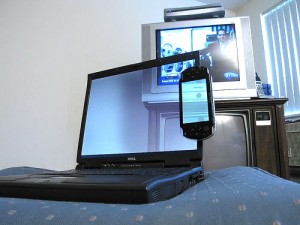Recently, I've noticed an emerging meme -- "a screen is a screen is a screen." This or similar phrases suggest that only total time matters in children's relationship with media, not what's being viewed or used by whom, nor how and why. As used, it's a facile way to tar all media and absolve parents or activists from doing the hard work of addressing specific content or context.
For example, last month the American Academy of Pediatrics released its updated policy on children and media. Not surprisingly, the AAP's new guidelines reiterate its "no screen time for under twos" position; dismayingly, they also treat enormous technology evolution almost coincidentally and entirely negatively (the "new technology" section addresses only sexting, porn and pro-anorexia websites). In a New York Times article on young children and mobile media, a member of the AAP's Council on Communications suggests the current landscape was just too difficult to parse in its revisions, saying "at the moment, we seem to feel it's the same as TV."
Around the same time, an article on the trusted content review site Common Sense Media advised parents that "as long as you limit the total screen time and choose age-appropriate shows, games, and websites, a screen is a screen is a screen." Quality content depends on far more than being age specific, but more important, it's absurd to suggest that one platform could be "better" than others, agnostic of content.
Back when children's media options were primarily storytelling delivery systems (TV, CDs, VHS/DVD, movies), equating screens might have been acceptable. Today, by contrast, kids encounter "lean back" media like TV and "lean forward" platforms like the web; touch, tap and tilt mobile media and the new sine qua non of active, whole-body engagement, the Kinect (the New York Times' David Pogue says, "You can't play Kinect sitting down, and that's a plus").
This is why it's frustrating when a blogger for Kidglue, a site that claims to help parents "engage their kids through popular culture," not only says all screens are equal (and none necessary), but also that electronic devices only "frustrate" small children. She would need only to see this remarkable video of toddlers with iPhones/iPads (compiled by Children's Technology Review editor Warren Buckleitner) to understand that, in tiny hands, the direct response of a multi-touch screen is day and night from the hand-eye coordination required to wield a mouse.
Debates about whether "a screen is a screen is a screen" range and rage, from marketing to early learning. Moving beyond the hyperbole, though, here are a few thoughts that might help parents make smart use of the many media options available.
There's no transitive property of screens. You can watch video on an iPad, but you can't run apps on a TV, so while young people's TV viewing increasingly is time-shifted or done on devices other than the 42-inch flatscreen, many other gratifications young people seek from media can exist only on specific screens. Given the findings of the Kaiser Family Foundation's "Generation M2" study -- that young people multi-screen, multi-task and add new devices without displacing old ones -- they themselves appears to view different screens as having unique and parallel, not identical, functions.
Context is as important as content. Time, place and purpose matter. Screens can be fixed or mobile; some excel at storytelling and others at gaming; different media are solitary or social; devices may be self-contained and may around the world. A PSP to relieve anxiety at the doctor's office is different from taking pictures with an iPhone on a walk, which is not the same as channel-surfing, which is unlike illustrating a story with "KidPix."
Screens aren't inimical to reading, outdoor and imaginative play. Most often, messages to parents about "screen time" are bundled with cautions about it displacing more valued activities. This was disproved in the Kaiser study; even so, careful choice of screen and content can be a facilitator -- interactive eBooks may help children catch the reading habit; innovative apps like "Google Goggles" or the augmented reality game "Hidden Park" can add adventure to outdoor play. Smart parents use these as supplements, and not replacements for books, neighborhood exploration or free play.
Different screens, different levels of control. Even for today's "digital native" parents, keeping up with the constant introduction of new devices and flood of content can be daunting. This is another reason not all screens are equal; each offers unique ways both to find the best content and to avoid what you don't want. Parents can choose among levels of gate-keeping and curatorial oversight, from television's limited channel menu offering pre-selected content scheduled or on-demand, to the iTunes and App stores with nearly unlimited bandwidth but an editorial team deciding what to sell, to the "wild west" frontier of YouTube and the Internet.
Like parents, content creators are also struggling to make best use of the various screens. The best producers resent the "screen is a screen is a screen" meme because it frees those who are less scrupulous to throw "shovelware" into a scary, fast-changing market. Happily, it seems that the industry is transitioning from "360 commissioning" (wanting one's stories and characters to be on all platforms regardless of fit, for fear of leaving eyeballs or money on the table) to "transmedia," which emphasizes each screen's unique contribution to a coherent whole.


